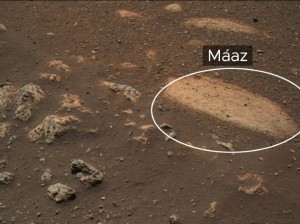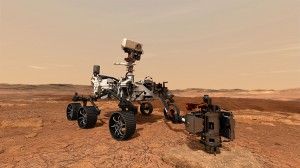Ha’ahóni on Máaz (Perseverance on Mars)
Wednesday, May 26th, 2021
This rock, called “Máaz” (the Navajo word for “Mars”), is the first feature of scientific interest to be studied by NASA’s Perseverance Mars rover.
Credit: NASA/JPL-Caltech
When you’re exploring a planet, you have to name things. It’s a great way to memorialize your discoveries, but it also prevents confusion: are you going to study This Rock, That Rock, or The Other Rock?
The United States National Aeronautics and Space Administration (NASA) mission Mars 2020 is hard at work exploring Mars. The mission’s rover, Perseverance, landed on Feb. 18, 2021, in Jezero Crater. The mission planners have been naming important surface features in the Navajo language. This decision wasn’t planned before the rover landed, but came about by happy circumstance.
Landing on another solar system body is tough. Mission planners can guide a lander to a general destination, but they cannot pinpoint an exact landing site. Mars 2020 mission planners could guide Perseverance to Jezero Crater, but they could not know where in the 28-mile (45-kilometer) wide crater the rover was going to land. Therefore, mission planners studied the entire crater to prepare for landing. They divided the crater into several sections, naming each after a place on Earth—including U.S. national monuments—that the section resembled in some way.
Perseverance landed within the section that planners had named after Canyon de Chelly National Monument. This national monument, known for its huge, colorful, steep-walled canyons, lies entirely within the Navajo reservation. The Navajo are one of the largest Native American groups in the United States. The Navajo reservation, which covers 16 million acres (6.5 million hectares), is the nation’s biggest reservation. It includes parts of Arizona, New Mexico, and Utah.

Canyon de Chelly National Monument (“Tséyi’” in Navajo) in Arizona is located on Navajo Nation land. Members of NASA’s Perseverance rover team, in collaboration with the Navajo Nation, has been naming features of scientific interest with words in the Navajo language.
Credit: NASA/JPL-Caltech
NASA’s Mars mission scientists informally name important features to make them easier to identify. Mars 2020 mission scientists were inspired by the name of their landing site to nickname features in the Navajo language. They teamed up with NASA Jet Propulsion Laboratory (JPL) scientist Aaron Yazzie, who is Navajo, to seek permission from the Navajo Nation. The nation’s government approved the idea and developed a list of potential names. The first name to be used was Máaz, the Navajo word for Mars, for a rock near the landing site. Navajo officials also included the translation for Perseverance: Ha’ahóni.
Perseverance has to be “taught” the language, since the computer languages the rover uses cannot process the special characters and diacritical marks used in the written Navajo language. Mars 2020 team members are working to develop better transliterations using the English alphabet.
This is not the first time the Navajo language has played an outsized role in United States history. During the United States’ involvement in World War II (1939-1945), Navajo radio operators sent secret messages using a code based on the Navajo language. At the time, Navajo was an unwritten language known to few people outside of the Navajo Nation. Its complex structure, difficult pronunciation, and singsong qualities made it nearly impossible to decipher. Although Imperial Japanese forces could overhear the messages, they never managed to decode them. The Navajo radio operators, called code talkers, have been honored for their service in the war.
Mars 2020 has shed its proverbial training wheels and is breaking new ground in the exploration of the Red Planet. The helicopter Ingenuity, another part of the mission, conducted its first flight on April 19. Engineers are now pushing Ingenuity further, conducting longer, more challenging flights. The craft’s performance will gather valuable information for future Mars flyers. Perseverance’s robotic arm began conducting science on May 11. As the mission continues to explore, planners will continue to nickname features in the Navajo language—a tribute to the Navajo people, their culture, and the land they call home.



